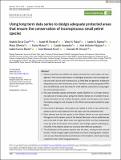Por favor, use este identificador para citar o enlazar a este item:
http://hdl.handle.net/10261/348716COMPARTIR / EXPORTAR:
 SHARE SHARE
 CORE
BASE CORE
BASE
|
|
| Visualizar otros formatos: MARC | Dublin Core | RDF | ORE | MODS | METS | DIDL | DATACITE | |

| Título: | Using long-term data series to design adequate protected areas that ensure the conservation of inconspicuous small petrel species |
Autor: | De la Cruz, Andrés; Pereira, Jorge M.; Paiva, Vitor H.; Ramos, Jaime A.; Oliveira, Nuno; Alonso, Hany; Saavedra, Camilo; Vázquez, José Antonio CSIC ORCID; García-Barón, Isabel; Arcos, José Manuel; Arroyo, Gonzalo M. | Palabras clave: | At-sea census ensemble species distribution modelling | Euorm-petrel Iberian Peninsula important bird area marine protected areas seabird conservation |
Fecha de publicación: | 24-oct-2023 | Editor: | Wiley-Blackwell British Ecological Society |
Citación: | Journal of Applied Ecology 60(12) : 2586-2601 (2023) | Resumen: | Marine protected areas (MPAs) are widely used tools for conservation and management. Their correct delimitation is challenging, especially when the target species are small, elusive and inconspicuous, as little data are generally available to adequately assess their distribution at sea. Therefore, currently designated MPAs may not effectively cover key areas for small seabirds, particularly during migration and wintering seasons. We used ensemble species distribution models (ESDMs) on a 15-year time-series data set of at-sea census along the Atlantic Iberian arc to predict the potential distribution of the smallest European seabird, the European storm-petrel (Hydrobates pelagicus), and compare it with official marine special protection areas (SPAs). Occurrence of European storm-petrel was related to shifts in sea surface temperature, and to small distances from the coast over the continental shelf. Most relevant area for the species in the Atlantic Iberian arc was west-central Portugal to north-western coast of the Iberian Peninsula, with an additional key area in the Gulf of Cádiz. Both zones host significant SPAs, but they inadequately cover key areas for European storm-petrels. Our findings support extending marine SPAs in the Atlantic Iberian arc to ensure their effective protection. The distribution of the species expands over the years, varying in both size and location. These changes might be attributed to dynamic oceanographic variables, such as sea surface temperature and biomass of micronekton, which seem to play a significant role in their foraging behaviour. Synthesis and applications. Our study highlights the importance of analysing long time series and ESDMs to design adequate protected areas, which ensure the conservation of small and highly mobile species such as storm petrels. Our results should be considered by decision-makers to prioritise and update marine protected areas, while incorporating the dynamic nature of the ocean within an ecosystem-based approach. | Versión del editor: | https://doi.org/10.1111/1365-2664.14524 | URI: | http://hdl.handle.net/10261/348716 | DOI: | 10.1111/1365-2664.14524 | ISSN: | 0021-8901 | E-ISSN: | 1365-2664 |
| Aparece en las colecciones: | (IEO) Artículos |
Ficheros en este ítem:
| Fichero | Descripción | Tamaño | Formato | |
|---|---|---|---|---|
| Journal_Applied_Ecology_2023_Cruz_Using_long‐term.pdf | 7,46 MB | Adobe PDF |  Visualizar/Abrir |
CORE Recommender
SCOPUSTM
Citations
1
checked on 19-abr-2024
Page view(s)
13
checked on 26-abr-2024
Download(s)
2
checked on 26-abr-2024
Google ScholarTM
Check
Altmetric
Altmetric
Este item está licenciado bajo una Licencia Creative Commons

